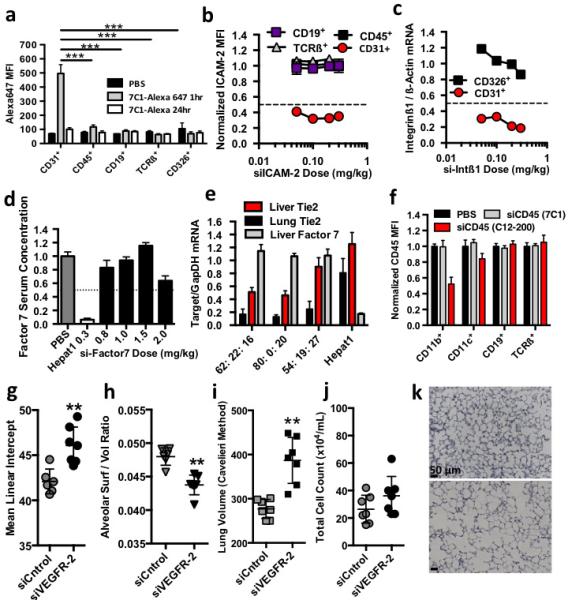Figure 3.

7Cl preferentially delivers siRNA to pulmonary endothelial cells in vivo. (A) Alexa647 median fluorescent intensity in pulmonary endothelial (C031+), hematopoietic (C045+), epithelial (C0326+), B (CDI9+), or T (TCRß+) cells isolated from mice after treatment with 7Cl formulated with Alexa647-tagged siRNA. Statistical significance calculated between endothelial cells and other pulmonary cell types one hour after injection. (B) ICAM-2 median fluorescent intensity in pulmonary cells (normalized to siCntrol-treated mice) isolated from mice three days followings treatment with 7Cl-silCAM -2. (C) Integrinß/ß-actin mRNA ratios (normalized to siCntrol-treated mice) in pulmonary endothelial and epithelial cells isolated from mice two days after treatment with silntegrinßl. (D) Factor 7 serum concentration (normalized to PBS-treated animals) two days following treatment with liver targeting molecule HepatOl-siFactor7 or 7Cl-siFactor7 (E) Tie2 and Factor7/GapOH mRNA expression following a 0.15 mg/kg injection of 7Cl concurrently formulated with siTie2 and siFactor7. Particles were formulated with different 7Cl: Cholesterol: C14PEGlOOO molar ratios. 7Cl decreased Tie2 mRNA expression in pulmonary, renal, and hepatic endothelium without reducing F7 mRNA expression. (F) C045 median fluorescent intensity following treatment with 7Cl-siC04S or positive control CI2-200-siC045. (G-K) Mean Linear Intercept (MU) between alveoli, pulmonary surface/volume ratio, total volume, and pulmonary histology following two 0.5 mg/kg injections of siCntrol or siVEGFR2. Increased MLI, alveolar volume, decreased surface/volume ratios, and constant infiltrating myeloid cells are consistent with an induced emphysema-like phenotype (N=6 to 7 animals / group, data shown as average +/− std, scale bar = 50 um)*p < 0.05, **p<0.002, ***p<0.00l.
